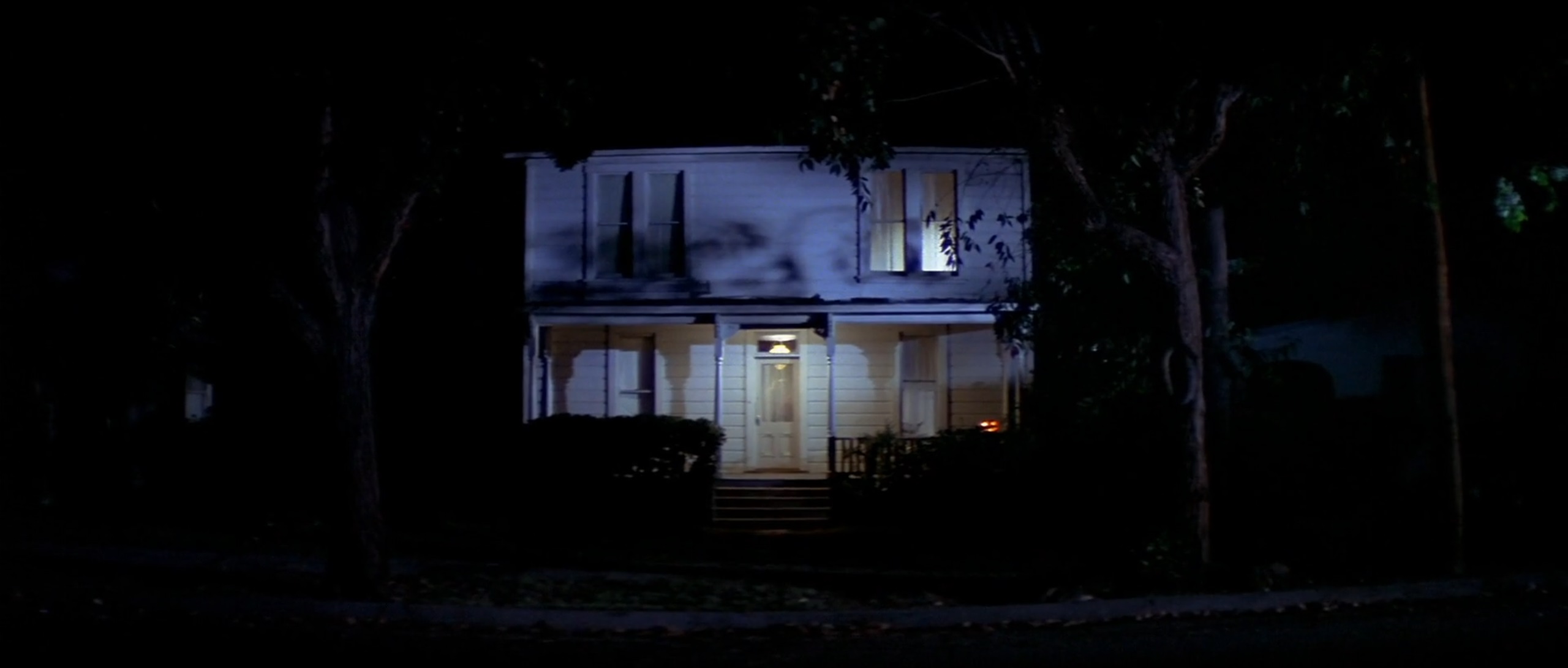 Halloween (1978) 00:02:24
April 9, 2023
Halloween (1978) 00:02:24
April 9, 2023
The Pervasive Sharp Cloud that En/vel/opes Haddonfield: Meyers / the Atmosphere of Halloween (1978)
Robert Spadoni’s 2003 essay, “What is Film Atmosphere”, attempts to explicate the definition of film atmosphere and what it pertains to/encapsulates within a film. Spadoni sees how film atmosphere has the capability of muting senses such as smell/perception/colors, or how the atmosphere of a film inversely heightens sensations, making the same sources or subjects pervading/imminent/saturating. Spadoni asserts a film’s atmosphere is inseparable (but distinct) from a film’s style (50). Film atmosphere is a guiding hand of a film, the calm breeze of “continuity” that pervades each shot/scene. In slasher films, it can be the thrusting hand and pervading movement of a violator that reorients the film and audience back to its tracks. Spadoni contends that film atmosphere is all-encompassing; it includes the close-up that reveals a character’s intentions, the non-diegetic soundtrack that sets the tension of a scene, the background sounds from the street corner, the establishing shot, and the ways these shots are edited together. They write “…every part of a film helps create it; and every film has it”/ atmosphere is all of a film and unique to every film (54). Spadoni’s essay explores a multitude of mentions of atmosphere in film reviews, critical analysis, and from theorists to attempt to nail down a meaning across metaphors of skin, weather, breath, aroma, and air. They arrive at a definition of something that is illusive, but illusive in nature/an aesthetic to film that engages in a back and forth with the audience and a film’s cinematic elements to disguise itself into the background. The atmosphere of a film is the either, the spirit, yet still highlights its presence and cooperation/coordination with all the other cinematic elements/components of a film. Atmosphere is paramount in horror films, specifically in the slasher genre due to the obligation to explicate the tensions and surroundings of the characters within the setting and mise-en-scene, to shade these elements into contrasts of fear/danger against safety/escape.
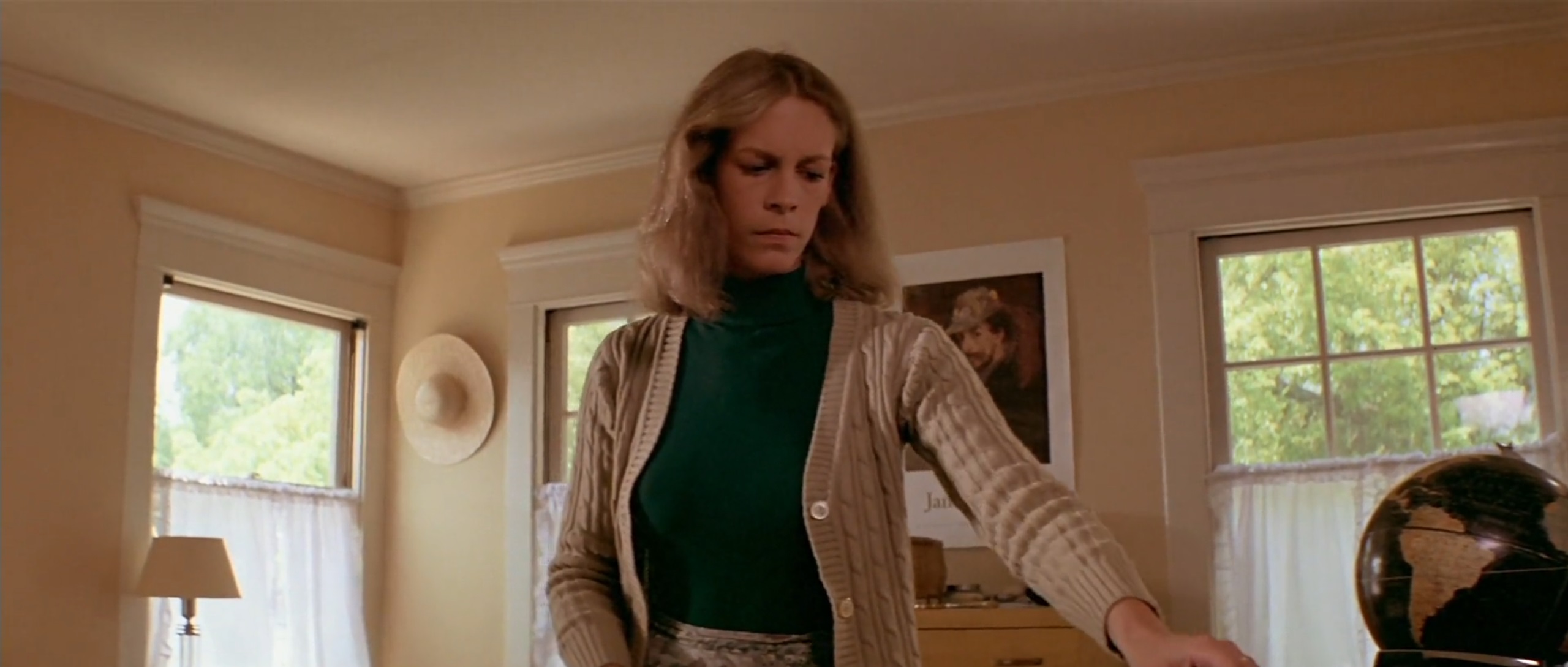 Halloween (1978) 00:27:19
Halloween (1978) 00:27:19
The original Halloween (1978) directed by John Carpenter, starring the prowling ephemeral being Michael Meyers (Nick Castle and Tony Moran)/the witness and subject of his trauma Laurie Strode (Jamie Lee Curtis), commands an atmosphere of sexual promiscuity/enforced chastity, rich blues/soft oranges, encroaching breezes/ever-present scopaesthesia (the phenomena of feeling like one is being watched), and is filled with the victims’/Meyers’ silent/unheard screams/footsteps. From the opening shot, the camera rides the breeze into Haddonfield in/around/above the Meyers household, but the camera is not the only thing caught up in this sharp, peering breeze. Michael, in this opening sequence as an adolescent, absolves/distills the atmosphere that will unfold throughout the film. Meyers is a pervasive and calculating threat, unlike the camera, however, he seems to command the seeping cloud/fog the characters/camera/audience become encircled within. The biting danger lurking behind and within the mise-en-scene of Halloween is not passively observed by the characters/victims, rather the film seems to suggest there is correlation/interaction between them. Examples of mingling interactions between various aspects of the film's narrative, which builds the tension of connectedness that paints the atmosphere, include Meyers’ gaze as he watches the young adults be intimate, Laurie coming to the house to place the key, and the impact of outside forces such as the house being repossessed/Meyers being imprisoned in the mental asylum. In the same way, the customs prevalent/environmental conditions in Haddonfield, such as the culture toward celibacy and the victims abstaining from it/the weather, including the storm resulting in Meyers’ escape and the wind flowing above and through the suburban homes/windows/streets, also play a role in manipulating/shaping the cloud that looms across the film. Just as Meyers is propelled by these interactions, the pervasive sharp cloud that envelopes/carves through Haddonfield like a knife is polarized by each action the film decides to peer towards. The film’s looming cloud-like atmosphere extends out towards the audience amongst the web of inter-connected nearness each shot and cinematic artifact brings to the next.
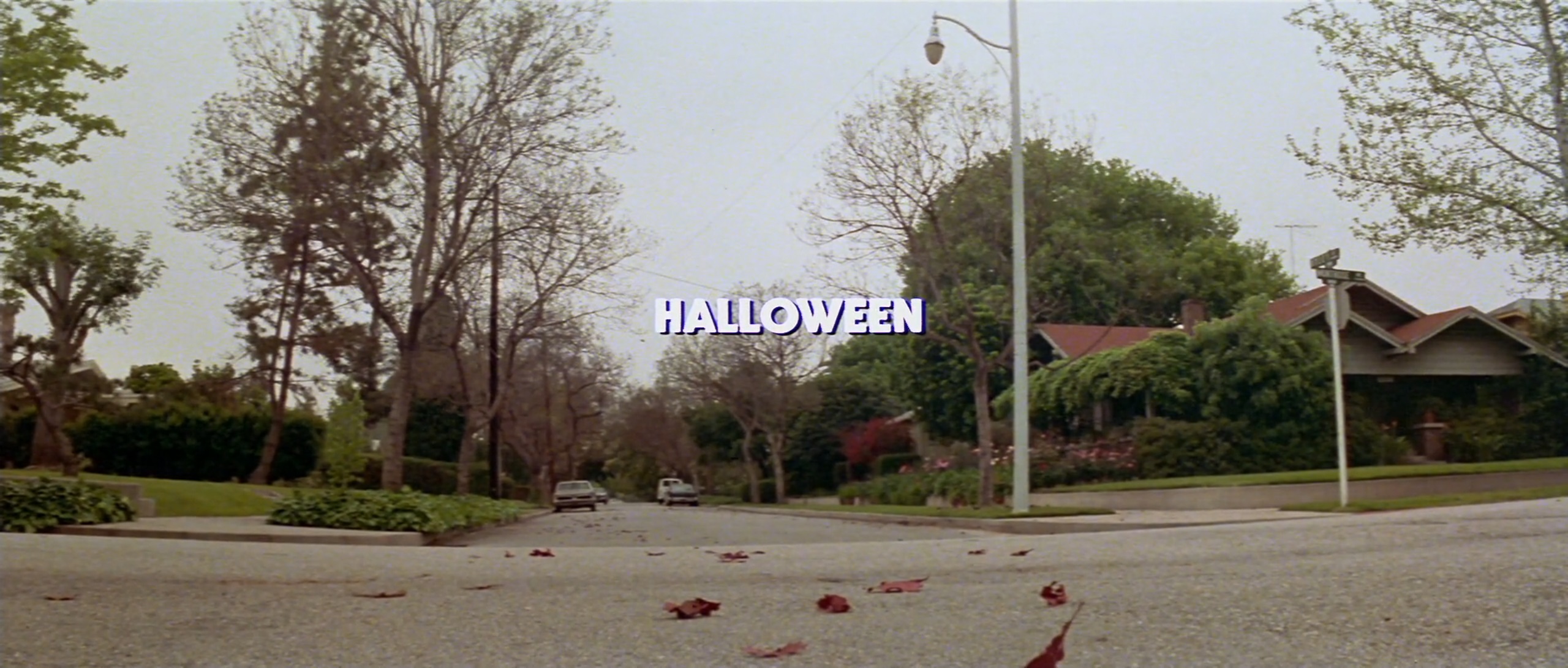 Halloween (1978) 00:11:20
Halloween (1978) 00:11:20
After Meyers escapes the asylum, the first shot of Haddonfield at 00:11:08-00:11:23 cuts from the thundering rain to a penetrating quietness broken only by chirping from birds, while a low-angle shot peers towards/across the street of the Strode and Wallace households. The intertitle of “HADDONFIELD” materializes in the center of the mise-en-scene in bold, white letters with black shadows. The sky is grey and overcast, making the daylight appear as a dim glow against the bare trees as a few leaves from overhead wander/blow onto and across the street. The trees stand almost motionless, mirroring Meyers himself, swaying in a slow procession that matches the gentle rise and fall of their chests in the breeze that settled across the landscape overnight. As the overcast atmosphere of the suburban town just begins to seep in, the intertitle is overlain/contorted. The beginning of the piano theme that inserts itself throughout the film begins to play and the intertitle of “HALLOWEEN” reveals itself. This formula, establishing a shot and then transfiguring its initial mise-en-scene/score (often with Meyers/his presence/the piano theme), is replicated in shots throughout the film as microcosms of the inevitable enveloping nature the cloud/breeze-like atmosphere that Meyers inflicts upon Haddonfield. The leading piano theme across the film seeps out of shots that may pose no immediate danger, but serves to building tension bridging Meyers’ first act in the opening sequence until his inevitable second on-screen killing of Annie (Nancy Kyes) in her car in the shot at 00:53:37-00:54:14. If, as Spandoni writes, “Atmosphere is not merely space but its emotional coloration”, then Halloween’s emotional coloration of the way the text conveys space is one of conflict/subversion: showing a way of escape and then Meyers occupying it/sexual liberation and expiration/Meyers there and then gone/incapacitated and then alert/a breeze blowing interrupted by the leading piano (53). Meyers can be seen as the breeze that invades and occupies Haddonfield and Halloween throughout the film, shading the contrasts that encroach within each shot and frame.
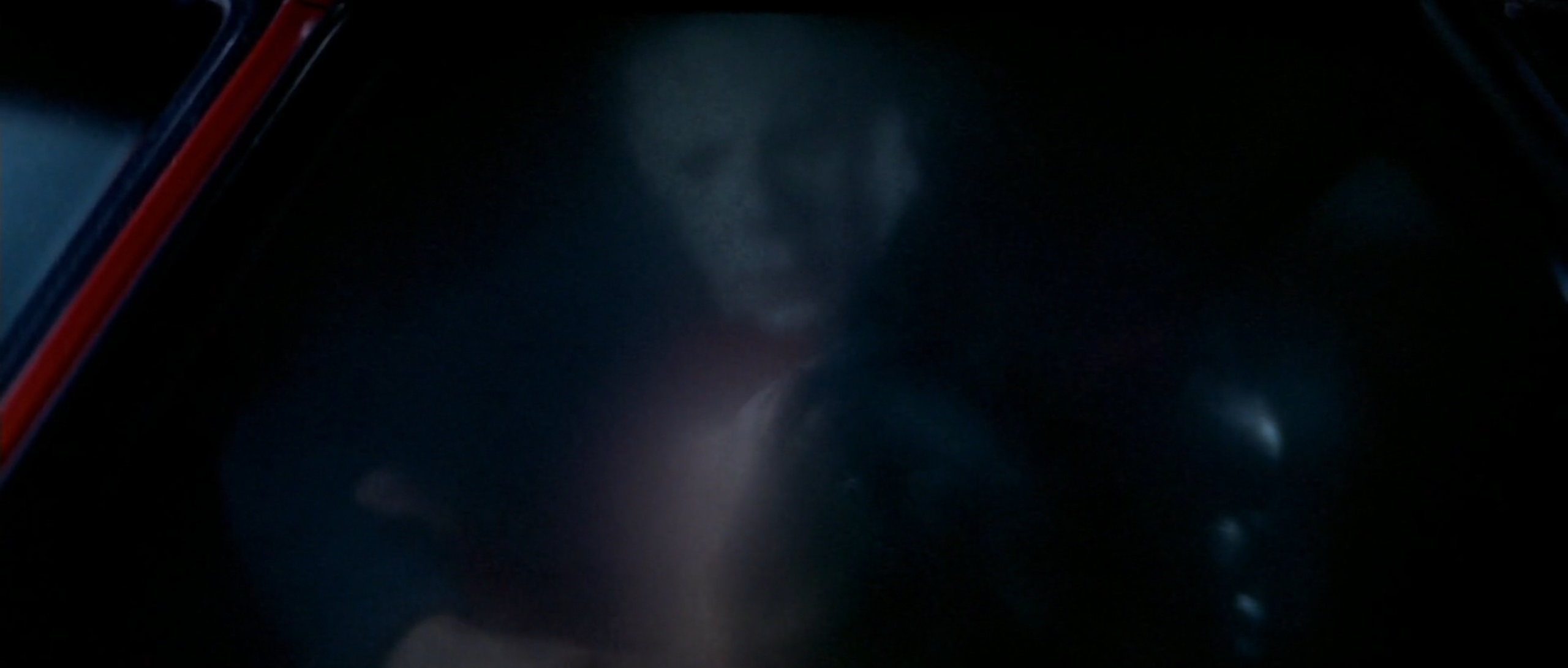 Halloween (1978) 00:53:39
Halloween (1978) 00:53:39
Meyers and the atmosphere are revealed but not known to the audience; felt but not revealed to the other characters. Through the matrix of Meyers’ character, the audience is aware of the danger lurking throughout Haddonfield and fears it. Simultaneously his opposition, other than that of Loomis (Donald Pleasence), is constantly vexed by a haze of being safe/being able to escape, until it is too late. Meyers seemingly knows things he should not know, how to drive, who to target for personal/sexual retribution, where to hide/go to confront his victims. Meyers also behaves in a superhuman/ultra-surrealist manner, surviving the shooting, overpowering the officer, displaying overwhelming strength, and the aptness to avoid detection even in close quarters. Loomis even laments about Michael in the shot at 00:36:43-00:37:26 after him and Bracket find the dead dog in the Meyers house, “This isn’t a man”. This difficulty nailing down Meyers’ qualities, despite their interwovenness, resembles/is a metaphor for the intrinsic fleeting complexion of the nature of film atmosphere, as well as of the cinematic framework of Halloween itself. The metaphor goes even as deep as the actor that is revealed in the frame 01:26:42, Tony Moran, is not the presence haunting/encircling most of the film. Nick Castle remains faceless across the runtime yet is the prowling ephemeral atmosphere of the film.
 Halloween (1978) 01:26:42
Halloween (1978) 01:26:42
From its establishing shot, Haddonfield is draped in the mise-en-scene by a palette of orange and washed whites/greens. Iterations of this orange within the cinematic world are Annie’s sweater and car, brake lights, incandescent bulbs, the wood furniture/peach walls, auburn hair, autumn leaves, the setting sun, jack-o-lanterns, and Laurie’s couch, each mixing alongside the whites and greens that bathe sections of the screen in swept pavements, exteriors of buildings, mowed lawns, looming trees/hedges, the sunlight, and the effervescent flowing garments/curtains Meyers lurks behind and across. In flashes during the opening sequence, and then resuming after the cut at 00:34:45, the oranges/whites/greens begin to become contrasted in the second half of the film with imposing shades/swathes of blues and blacks. The blues grow richer and darker through the moonlight, through objects such as Laurie’s sweater, Bob’s (John Graham) van, blue jeans, the increasing presence of Meyers’ jumpsuit, the electric glaze over the TV/lens flares, and by transposing whites. The coloration is capped off by absent canvas spaces of black namely the encroaching darkness, waiting shadows, frequent silhouettes, portal-like windows, Meyers’ dark hair/eye sockets of the mask, and Loomis’ gun that envelop every frame of the final act. Like the biting wind blowing around Loomis as he approaches Laurie’s house in the shot at 01:20:58-01:21:47, Meyers/the night/the sharp cloud inevitably is shown overtaking Haddonfield. The atmosphere’s exemplar completely flows through every open archway and character and then escapes like a ghost at the end of the film, blurring the atmosphere that “tells us where a film leaves off and its reception begins” (Spadoni 60).
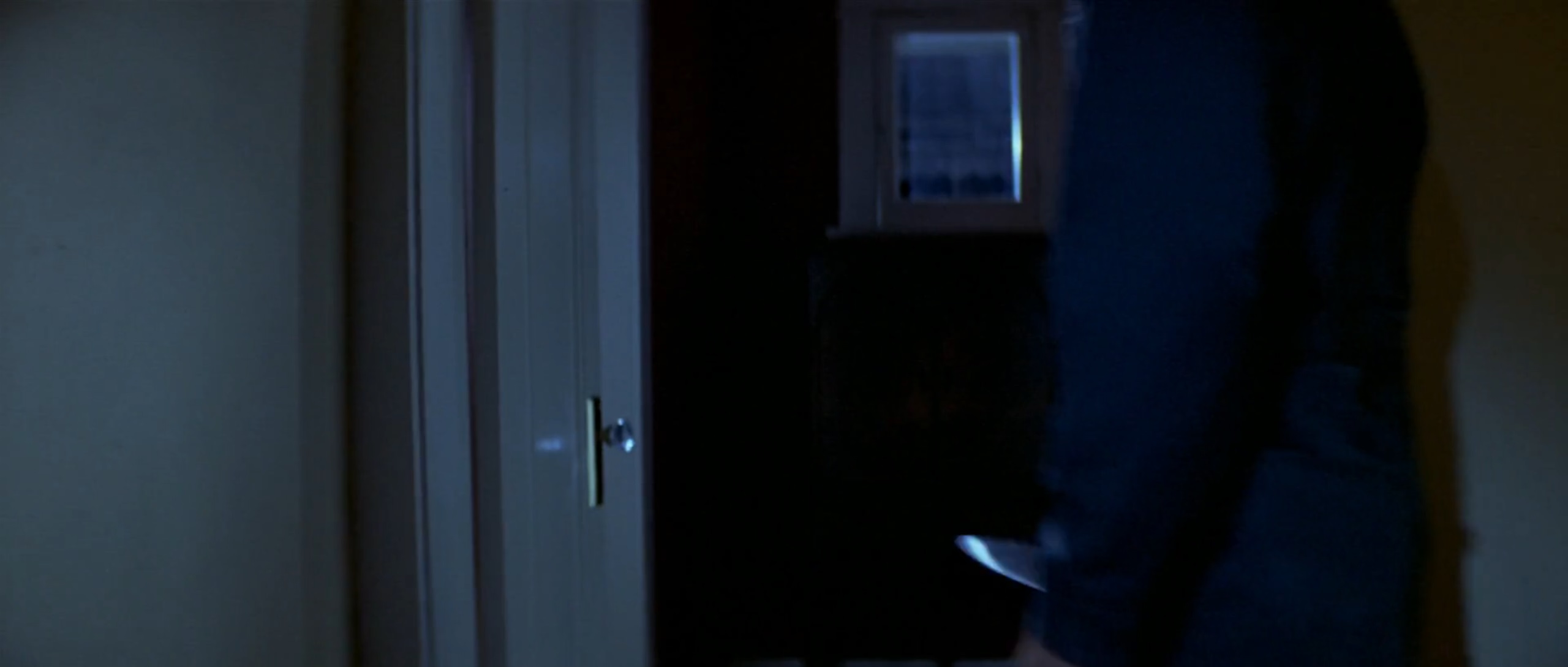 Halloween (1978) 01:22:52
Halloween (1978) 01:22:52
Halloween. Directed by John Carpenter, performances by Jamie Lee Curtis, Nick Castle, Donald Pleasence, and Tony Moran, Compass International Pictures, 1978.
Spadoni, Robert. “What Is Film Atmosphere?” Quarterly Review of Film and Video, vol. 37, no. 1, 2020, pp. 48-75. https://doi.org/10.1080/10509208.2019.1606558. Accessed 9 April, 2023.
Chandler Murray
e:Murrayc15@gator.uhd.edu